#japanese beginner
Text
にくい - Difficult to, Hard to
Verb in noun form[ます]+ にくい
Polite: Verb in noun form[ます]+ にくい + です
Like 易い (やすい), にくい is an い-Adjective that is regularly attached to the ます stem of verbs, communicating the difficulty of performing the verb that precedes it. In other words, the verb, aka whatever is difficult to do, will always come before にくい.
The nuance of にくい is that a task is difficult to do because of the required skill level or similar factors.
私には英語の「Literally」という単語がとても言いにくい。For me, the English word ‘literally’ is very hard to say. (Hard due to the individual's skill level)
アフリカには行きにくいです。It is hard to go to Africa.
This is different from づらい, which focuses more on a task that is difficult due to being unbearable/hard to endure for some other reason (such as emotional). For example:
お前には本当に言いづらいけど、お前のギターを壊した。ごめん。This is very difficult for me to say to you, but I broke your guitar. I'm sorry. (Hard because the speaker knows that telling the listener will cause a negative response)
#japanese#learn japanese#japanese studyblr#how to learn japanese#studyblr#learning japanese#hiragana#japanese beginner#japanese langblr#japanese for beginners#N4#n4 grammar#japanese n4#japanese lesson#japanese grammar#learn how to speak japanese
84 notes
·
View notes
Text

あきらめない - akiramenai - I won't give up ♡
I made this for myself - to remind me to keep trying ♡

#you can use it too if you want!!#its all in hiragana because thats easier for me and other beginners to read - forgive me!#akiramenai#あきらめない#langblr#japanese langblr#japanese#learning japanese#japanese beginner#beginner japanese#japanblr#japaneseblr
151 notes
·
View notes
Text
STUDYBLR i need help rq ;;
for the most part i've got hiragana memorized, i was gonna start on katakana, but immmm wondering when i should start kanjiii... should i start after i learn katakana, or after i start learning sentences and words and sentence structure and all that? or some secret 3rd thing idk.. ;;
(if it helps, i memorize faster if i do things one at a time and get to dedicate all my focus to a very specific thing [adhd moment])
#learning japanese#japanese langblr#langblr#language learning#language study#┊♪┊. kieren's rambles#japanese learner#studyblr#japanese beginner
4 notes
·
View notes
Text
こんにちは!わたしはJeremyです。わたしはアメリカ人です。
(Hello! I am Jeremy. I am american.)
Started learning Japanese yesterday. Memorized how to say hello, my name, and that I'm american. very happy :)
#nihongo#いほんご#learning japanese#japanese beginner#jlpt n5#actually autistic#aac user#semiverbal#high support needs#medium support needs#level 2 autism#language disorder
10 notes
·
View notes
Text
Hiragana and Katakana Part 1
So before getting into Japanese there are some fundamentals that we all need to know. You may already know it, but bare with me and let's have a bit of a review.
For Japanese, you may or may not know but there are three styles of writing. It's fairly easy to tell them apart so there is no need to worry about forgetting which is which. In this post we’ll learn about two of them.
The first is called 'Hiragana'.

You can always tell it's Hiragana by how soft and round the characters look. There are a total of 46 characters and each one follows a simple sound profile. It's always consonant followed by a vowel. For a pronunciation guide you can follow this link to youtube
How did you do? Ready to try putting them together? Awesome!
Try reading this ねこ
Did you get it? The reading for it is ね(ne)こ(ko)
Congrats! You just said 'cat' in Japanese! Here is some other's to practice with.
いぬ
いけめん*
ほん
すき
(1) inu = dog (2) ikemen = handsome guy
(3) hon = book (4) suki = to like
I have the feeling that you guys knocked that out of the ball park! Let's try leveling that up a bit and make a sentence. Try reading this.
ほん が(ga) すき で(de)す。
Can you guess what it means? If you said "I like books" then give yourself a gold star because that's right! You can change the part in red to anything you want. Try it!
You may also be wondering what are those thing that look like quotation marks above the か and て, but don't worry I will explain it in my part 2 Post. For now let's get to the next set of characters: Katakana

Katakana, unlike hiragana, doesn't have soft pretty curve to it. Instead its more blocky and rigid. As you can see from the chart, there are more straight lines when writing in katakana.
HOWEVER, the pronunciation for both katakana and hiragana are the exact same!!
Now isn't that just lovely? It may be hard because you have to learn two different characters for the same sound, but at least its not 46 completely new types of sounds! Now that would be a headache.
You might be thinking right about now, “Ok, whats the point of having two characters if they sound the same? That’s just more work!”
Trust me, I had those same questions. Even now I find myself forgetting how to write in katakana every now and then. However, there is a purpose for it. while I wont get too in depth for now, one of the most common uses for katakana is when they are used in loan words.
By that I mean words that aren’t originally Japanese. For example the English word ’illustration’, when translated to Japanese become a shortened version and is just ’Illasto’
Japan took that word and incorporated it into its own language so when written its commonly done so as イラスト. Katakana is also used in slang words. Earlier we used the word いけめん, a slang used for good looking men, but there was an astericks beside it. That’s because, it’s typically written in katakana. For my fellow otome game players you can see this in the Japanese game titles.
イケメン王子 Ikemen ouji
イケメンバ(ba)ンパ(pa)イヤ Ikemen vampire
イケメン源氏伝 Ikemen genjiden
That only scratches the surface of other ways katakana is used, but you can always ask me if you have any questions.

Theres one more picture so you can see the hiragana and katakana side by side comparison!
Hiragana and Katakana part 2
#Japanese beginner#hiragana and katakana#How was the explination? Easy to follow? Too much fluff lol?#Japanese explanation
39 notes
·
View notes
Text
6th February - 男の子+同じ
(I’m jumping into Kanji because I learnt ひりがな and かたかな last month!)
Today I put 50 more words from the JLPT N5 vocab list into a grand Quizlet so it’s now got 200 terms altogether! This is very passive study but it eases me into a session of studying. My motivation is often quite low and so I need to coach myself into studying like convincing a 5 year old to do their homework :)
I’m going to randomly generate numbers from 1- whatever number of terms I’ve got at the time in the Quizlet, and learn at least 5 kanji every day, less on a busy day. Today I had a lot of uni work to catch up on and so I only managed to learn 2. Better than nothing though !
(I use digital note taking for practice because the permanence of real paper demotivates me :( so my handwriting is better irl I swear, it’s just a little uglier on my tablet.
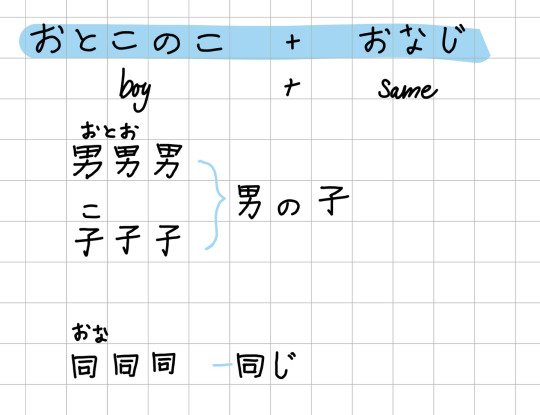
1 note
·
View note
Text
Japanese Reading Resources for Absolute Beginners
A question I encounter often is "How much Japanese should I study before I can begin reading in Japanese?"
From my experience as a learner and reader myself and from managing a Japanese book club for other learners I can honestly say that you can start way earlier than you probably think!
There are many resources that only require knowing hiragana. Those texts usually teach vocabulary through pictures and only use basic grammar.
Some are even simpler than that: The Japan Foundation's Hiragana Books are great for those, who are still remembering hiragana characters. Every short book introduces only 1-2 new characters, so it's a great reading exercise for those who've just started.

The free graded reader 「どうぞ、どうも」 by the NPO Tagengo Tadoku only uses the words 「どうぞ」 and 「どうも」 to write an entire story. Again, this makes for a great exercise in reading hiragana and understanding context. Another "level 0" recommendation by the same NPO would definitely be 「しろい?くろい?」. This book uses the full range of hiragana characters but the grammar is simple and all used vocabulary is illustrated.
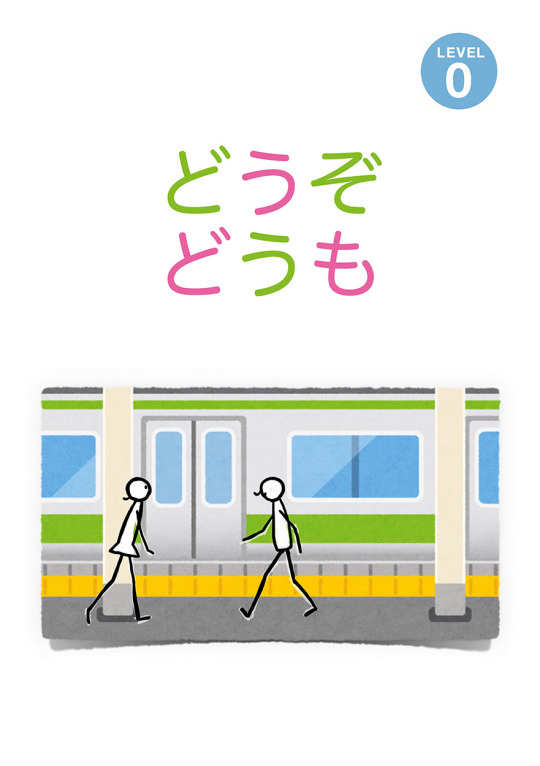
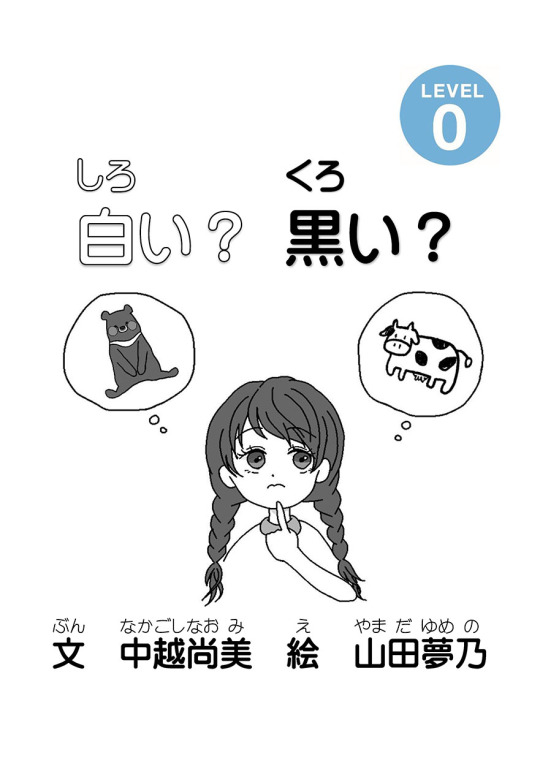
Another site with great resources for absolute beginners is Nihongo Tadoku Dōjō. If you have memorized both hiragana and katakana and know how the particles を and で work you will be able to read this text about stationary (ぶんぼうぐ) and understand everything by looking at the pictures!

The resources linked so far can all be accessed completely free on the linked websites. If you have the money to spare, please also have a look at the box 「スタート」 from the series reberubetsu nihongo tadoku raiburarī published by the NPO Tagengo Tadoku and ASK (affiliate link). This box includes 8 little books in very simple Japanese.
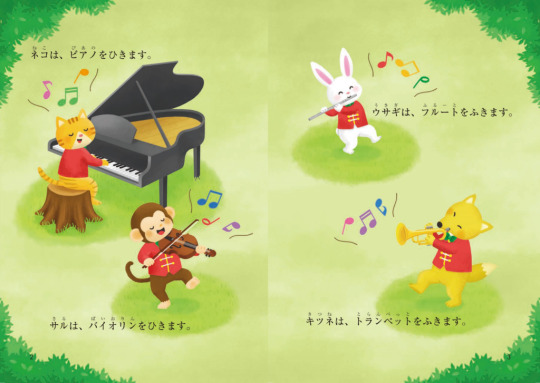
All these texts for absolute beginners will get you started reading in Japanese with very little knowledge of characters and vocabulary.
Reading in Japanese is a skill that requires practice. But once you get used to it, it can be such a valuable tool to reinforce new vocabulary and grammar. So please don't wait until you're "ready" before you start reading - start early at your own level!
#my book reviews#reading in japanese#study japanese#learning japanese#日本語#japanese books#やさしい日本語#free graded readers#free tadoku graded readers#nihongo tadoku dōjō#absolute beginner level#japanese langblr#japanese language#japanese reading comprehension#japanese free reading resources#japanese reading resources
650 notes
·
View notes
Text
IRL Japanese 2: Things the kids I teach say all the time
If you're planning to work as an ESL teacher in Japan working with kids, this vocab is gonna be super useful for you! You'll pick up a lot as you go along, but it's good to have an overview from the start.
できた = done, finished (whenever they finish an exercise I've set them. The older kids will use the ます-form, but kids under like age 8 will use this one)
かえる?= is it time to go home? (lit: go home?)
わかった = got it (again, the older kids will use the ます-form)
わからない / わかんない = I don't get it (idk if わかんない is just dialect or if it's common overall, but I hear it more than わからない. Usually from the kids who don't wanna be there and are making zero effort)
ちがう = wrong / different (when they give an answer but realise it's not correct. It's basically like "wait, no")
ばか = idiot (sometimes boys say this to their friends)
全部?(ぜんぶ)= everything?! (asked in disbelief when I ask them to write more than one word)
やめろ = stop it! (used with friends when they're teasing each other)
いたいよ = that actually hurts, you know! (used with friends when they're rough-housing)
よし (more like 'yoshhh') = right then (filler word indicating the start of an activity or a change of activity)
水筒(すいとう)= water bottle (most kids bring one to class and frequently forget to take them with them when they go home)
忘れた(わすれた)= I forgot (usually in reference to the text book they left at home)
トイレに行きたい = I want to go to the bathroom
先生、大好き!(せんせい、だいすき!)= I love you, Sensei!
Other useful classroom/school vocabulary:
サイコロ = dice
トランプ = playing cards
ごろごろ = onomatopeia for the sound for rolling (I found the kids got confused if I just mimed rolling a dice/ball and said "roll!" but if I did the gesture and said "gorogoro", they understood)
ビリビリ = onomatopeia for ripping (useful for when you have tear-apart crafts in class)
ケシケシ = onomatopeia for erasing something (useful when you try to explain to a kid they spelled something wrong. Because it's easier to just say "A kesh-kesh, E" than "Not A, E. Okay great you wrote E, but A needs to go. No no no not the whole word, just A. Oh my God. Okay. Let me write it and you copy.")
ちょっと = a little, soon, wait a little (useful if the kids are getting a bit antsy and ready to go home a bit too early/don't want to wait their turn. Don't use it with parents though!)
がんばれ = do your best / you can do it!
あぶない!= dangerous / look out! (useful if a kid unexpectedly runs in front of me while I'm carrying a table)
せえの!= Altogether now! (When I need the kids to repeat something after me)
だめだよ = Don't do that (for when the kids repeatedly do something I've asked them not to do)
少々お待ちください(しょうしょう おまち ください)= polite form of "please wait a moment". Useful if you have a parent talking to you and you need to go get something (e.g. a communication sheet for them to point at so you know what they're trying to say)
授業参観 (じゅぎょうさんかん) = parent observation (PO). A couple of times a year, parents are invited into the classroom to watch the lesson (absolutely not a thing in the UK, not sure about other countries). The past two months I've had POs at my various schools, and so the parents come to the door and ask me if it's PO week. I don't understand most of the question, but I can pick out this one word and a question particle and figure out what they're asking.
It's also obviously a good idea to learn vocabulary related to stationery (eraser, pencil, crayon, pen, notebook, textbook, pencil case etc) because kids forget/lose their stuff all the time and will inevitably ask you if they can borrow something.
505 notes
·
View notes
Text
Energy Explained in Other Systems
There is a lack of measurable evidence because any person that has worked with energies have had different experiences but were able to understand and manipulate energies according to their own will.
Energy has been used in many ways within culture and religion and have set beliefs depending on the system being practiced.
Next, are some given definitions defining energies within diverse philosophies.
Hindu = Prana
Chinese = Qi /Chi
Japanese =Ki
Greek = Pneuma
Hawaiian = Mana
Tibetan Buddhism = Lung
Hindu Philosophy
A Sanskrit word for "life force" or "vital principle" is often referred to as Prana. It is described as first coming down from the Sun and connecting all elements of the Universe. It has been invoked within the Hindu scriptures of the Vedas and Upanishads.
Prana is the belief of vitality surrounding all living beings. This energy is responsible for all bodily functions. There are five types of pranas, collectively known as the five vāyus.
1. Prāṇa: Beating of the heart and breathing. Prana enters the body through the breath and is sent to every cell through the circulatory system.
2. Apāna: Elimination of waste products from the body through the lungs and excretory systems.
3.Uḍāna: Sound production through the vocal apparatus. It represents the conscious energy required to produce the vocal sounds corresponding to the intent.
4. Samāna: Food digestions, repair or manufacture of new cells and growth, and heat regulations throughout the body.
5. Vyāna: The energy that is needed for the body to have proper circulation, and the functions for the voluntary muscular system in which there is expansion and contraction processes throughout the body.
Chinese Philosophy
The earliest texts in which Qi or Chi is described was in 'Analects of Confucius' where it could mean "breath" and was combined with the Chinese word for blood.
Xue-qi, "blood and breath."
Living beings are born because of an accumulation of qi, and as the beings live out their lives the qi declines eventually resulting in death. This indicates that xue-qi referred to all living things, but it is believed that qi or chi exists within all things tangible.
For example, the wind is the qi or chi to the Earth, and the cosmic concepts of yin and yang are "the greatest of qi"
Yin and Yang which means "bright-dark," and "positive-negative" are the opposing forces needed in order to complement the concept of balance. There are thoughts that this duality symbolizes contradicting energy forces which manifest as light and dark, fire and water, expansion, and contraction. With this said, Chinese medicine states that the balance of negative and positive forms in the body are believed to be essential for overall satisfactory health.
Japanese Mythology
During the sixth and seventh centuries the Chinese word qi (or chi) was written using the same kanji script for their interpretation for energy being "Ki"
However, the meanings are a tad different.
While the Chinese use chi or qi to describe that energy exists in all things, animate and inanimate objects, the Japanese believe it is the creative flow and expressions used within our daily lives, martial arts, and symbolizes aspects of nature, and thusly the spirits. It is the transfer from living, animate beings in to inanimate which can change and manifest into various forms. It is the necessary intentions one wields.
Greek Mythology
Pneuma, "The breath of life" or "vital spirit" is composed of kinetic energies within the vessel, while Ignis is composed of thermal energies. All human beings need both kinetic and thermal energies in order to properly function.
In Greek medicine, pneuma is the form of circulation throughout the body's vital organs. Due to this the role, pneuma plays within the body to sustain consciousness. Some physiological theories suggest that the pneuma mediates between the heart, and the heart is regarded as the seat of the mind, and the brain.
In similar, Stoic philosophy, pneuma is the active and generative principles that are organized between the individual and the cosmos. The highest forms are the Gods, and the human soul. The human soul is believed to be fragments of the gods given life force in order to be born and given a vessel upon the physical plane. This exists within all animate and inanimate objects as energy transfers and changes.
Hawaiian Mythology
Mana, the spiritual energy of power and strength. This energy exists within places and people; however, it is said that mana is both external and internal concepts.
The Hawaiian people believe that individuals can gain mana or lose it depending on one's actions in everything that they do.
In mythology there were two ways to gain mana, and this was either done sexually or through violence.
To sexually gain mana one must invoke the god, Lono, deity of peace and fertility.
To gain mana through violence one must invoke the god Ku, deity of war and politics.
Tibetan Buddhism
Lung means the wind or breath. Exists as a key concept in Vajrayana traditions. Generally, it's concept relates to the understanding of the subtle body, and Three Vajras. Those three are the body, speech, and mind. Lung relates to the subtle flow of energy and the five elements. (Fire, Water, Earth, Space, and Air) Lung is mostly closely connected to the Air Element.
Lung has also been used to describe the winds or prana being used in conjunction with the subtle body during a time of exercise, but also more importantly everyday functions of the body and its own senses. There are five psychic winds which manifest into mahabhuta. These five relate to the lifeforce that animate the body-mind (namarupa) of all sentient beings.
The Five Root or Major Winds
The root winds support an element and is responsible for a function of the human body.
The 'life-supporting wind' (Tib. སྲོག་འཛིན་རླུང་, sok dzin lung; Wyl. srog 'dzin rlung).
Located in the brain, this lung regulates functions such as swallowing, inhalation, and concentration.
The 'upward-moving wind' (Tib. གྱེན་རྒྱུ་རླུང་, gyengyu lung; Wyl. gyen rgyu rlung).
Located in the chest and thorax, this lung regulates, among other things, speech, the body's energy and vitality, memory, mental endeavour and diligence.
The 'all-pervading wind' (Tib. ཁྱབ་བྱེད་རླུང་, khyap ché lung; Wyl. khyab byed rlung). Residing in the heart, this lung controls all the motor activities of the body.
The 'fire-accompanying wind' (Tib. མེ་མཉམ་གནས་རླུང་, me nyam né lung; Wyl. me mnyam gnas rlung). Found in the stomach and abdomen area, the fire-accompanying wind regulates digestion and metabolism.
The 'downward-clearing wind' (Tib. ཐུར་སེལ་རླུང་, thursel lung; Wyl. thur sel rlung). Located in the rectum, bowels and perineal region, this lung's function is to expel faeces, urine, semen, and menstrual blood. It also regulates uterine contractions during labour.
The Five Branch Winds
The five branch winds enable the senses to operate.
The naga wind (Tib.ཀླུའི་རླུང་, lu'i lung; Wyl. klu'i rlung). This lung connects with the eyes and sight.
The tortoise wind (Tib. རུ་སྦལ་གྱི་་རླུང་, rubal gyi lung; Wyl. ru sbal gyi rlung). This wind connects with the heart and the sense of hearing.
The lizard wind (Tib.རྩངས་པའི་རླུང་, tsangpé lung; Wyl. rtsangs pa'i rlung) associated with the nose and the sense of smell.
The devadatta wind (Tib.ལྷས་བྱིན་གྱི་རླུང་, lhéjin gyi lung; Wyl. lhas byin gyi rlung) related to the sense of taste.
The 'king of wealth deities' wind (Tib. ནོར་ལྷ་རྒྱལ་གྱི་རླུང་, nor lha gyal gyi lung; Wyl. nor lha rgyal gyi rlung). This wind connects with the body and the sense of touch.
#energy work#pagan#witch#witch community#pagan witch#witchblr#witchcraft#beginner witch#baby witch#witch tips#energy manipulation#philosophy#theology#greek mythology#hindu mythology#buddhism#hawaii mythology#chinese mythology#japanese mythology#metaphyics#metaphysical#spiritualism#spirituality
331 notes
·
View notes
Text
[Japanese→English] @panmaumau Tweet — Color Coded Translation

————————————————————————
何も知らない生き物の顔
なにもしらないいきもののかお
The face of a living thing that doesn’t know anything.
————————————————————————
Please correct me if I made a mistake
#color coded translation#japanese#japanese vocabulary#study japanese#japanese lesson#easy japanese#beginner Japanese#learning japanese#japanese lingblr#japanese linguistics#learn japanese#japanese langblr#japanese learning#japanese language#japanese vocab
83 notes
·
View notes
Text
How to learn Japanese online for beginners
If you want to learn Japanese online but don't know how to start, here are some basic steps for you:
Learn Hiragana & Katakana
Familiar with basic Kanji and words
Start with Japanese grammars
Immerse yourself in Japanese
Practice, practice & practice
Furthermore, learn basic phrases also makes you practice Japanese more fluently!
Now, if you need more details about each step, this website is for you. It includes all you need to learn Japanese online.

66 notes
·
View notes
Text
れる・られる Intro to Passive Verb Form
Disclaimer: This is N4 grammar. If you don't know the difference between ru (ichidan) verbs and u (godan) verbs, this post will be too difficult for you! You can read this article first.
If you need help reading kanji, I suggest downloading Yomichan. It helps you decipher texts quickly and easily that would otherwise be too difficult. More info on that here.
So without further ado, let's get into it!
Let's start with Tofugu's description: "The passive suffix 〜られる tells us that a verb is done to someone. It takes the emphasis off of who does the action, and places it on who is affected by the action." (But beware - The Japanese passive is not exactly the same as the English passive. More on that later.)
How to conjugate verbs to passive form:
-iru/-eru-verbs: Replace the last 「る」 with 「られる」
Examples
To eat: 食べる+られる = 食べられるto be eaten
To leave: 出る+られる = 出られる to be left
To close: 閉じる → 閉じられる to be closed
To see: みる → みられる to be seen
u-verbs: Change the last character as you would for negative verbs but attach 「れる」 instead of 「ない」
Examples
To drink: 飲む+ま+れる = 飲まれる to be drunken
To wait: 待つ+た+れる = 持たれる to be waited for
To buy: 買う+わ+れる = 買われる to be bought
To meet: 会う → 会われる to be met
To duplicate: 写す → 写される to be duplicated
To divide: 割る → 割られる to be divided
To write: 書く → 書かれる to be written
To learn: 学ぶ → 学ばれる to be learned
Irregular:
To come くる → こられる to have someone come
To do する → される to be done
Conjugating れる・られる
れる・られる is an auxiliary verb (cannot be used by itself, must be attached to other verbs), treated as an ichidan verb. Even if a godan verb is in passive form, 〜れる takes the conjugation.
Polite form
〜れる → 〜れます
To get pierced 刺(さ)される → 刺されます
Plain negative
〜れない
To not get pierced 刺されない
Plain past
〜れた
Was pierced 刺された
Plain past negative
〜れなかった
Was not pierced 刺されなかった
Forming a Passive Sentence
There are three main parts to a Japanese passive sentence:
An action: the verb of the sentence.
A doer: the person (or thing) that the action is done by.
An experiencer: the person who the action is done to.
Xは Yに 〜られる。
Typical passive sentence: は (or が, or を) indicates the receiver of the action, に (or による) indicates the doer of the action, and then you use the passive verb suffix.
Examples:
私のアイスクリームを兄に食べられた。My ice cream was eaten by my brother. (This sentence instead uses を to mark ice cream as the direct object. In this case the same particle would be used even if the verb wasn’t in potential form → 私のアイスクリームを兄に食べました。→ My brother ate my ice cream.)
新聞がジョンに読まれた。 The newspaper was read by John
私は部屋を綺麗にして、褒められた。I was praised for cleaning my room. (This sentence does not indicate the doer - as in who was doing the praising - hence there being no green).
変な話を親に聞かれた。My strange conversation was overheard by my parents.
私の牛乳を全部誰かに飲まれた。Someone drank all of my milk.
Remember, oftentimes unnecessary elements are omitted. Therefore, the experiencer may be dropped from the sentence (especially when the experiencer is you or their identity is obvious from context). And, just like in english, the doer may also get omitted.
#japanese#learn japanese#japanese studyblr#how to learn japanese#studyblr#learning japanese#hiragana#japanese beginner#japanese langblr#japanese for beginners#intermediate japanese#jlpt n4#n4 grammar#japanese n4#japanese passive form#passive#passive verb#today i learned#study japanese
68 notes
·
View notes
Text

I am a beginner who is still learning Japanese
yasashiku shite kudasai, wastashi no nihongo madamada desu kura.

やさしくしてください、わたしのにほんごまだまだですから。(only hiragana)

優しくしてください、私の日本語まだまだですから。(with kanji)
I made some banners to use in your text posts to let more experienced Japanese speakers know that you are still learning! I can make it in other colours if you want ♡

#please feel free to use them 💕#mine#text#japanese#japanese langblr#japanese language#japn#learning japanese#Japanese beginner#nihongo#nihongojin#japanblr#langblr#studyblr
7 notes
·
View notes
Text
a fellow japanese learning friend told me there's 2 major "weed-out" learning curves to japanese, and that's 1) learning hiragana and katakana and the 2) learning kanji.
but I propose that there's a 3rd difficult learning curve and that's when you're in what I've called The Intermediate Soup where you don't have any specific thing to work on anymore but you know that you aren't There Yet
#mocha speaks#japanese langblr#learning japanese#like. you already know hiragana/katakana and know enough kanji to make it through some readings#and you can speak a little and write a little#but there's no more easily defined goalposts and the ones that exist (like going by JLPT) are still nebulous#and even beyond things like JLPT you can be N1 level and still not know a lot of things.......#anyways in the Soup you just have to make your own goals but that's hard when most resources are for people not in the Soup#(i.e. still somewhat beginner focused)
20 notes
·
View notes
Text
JP stitch event spoilers!!
the guys built a cottage using magic and stitch's help in one day wth

riddle says that they were a bit confused on how to build the cottage, but stitch seemed to have a lot of experience
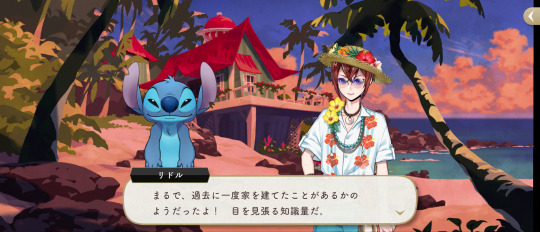

i wonder why🤡


for people who don't know lilo and stitch, stitch repeatedly destroys lilo's house in the movies and the series, so indeed he has a lot of experience
also floyd has a really big fixation on building a campfire, and tries convincing everyone they needed to build a campfire despite it not being necessary for survival

but he manages to convince them, and stitch makes ukuleles and he literally has a ken moment where he just strums the ukulele in front of the campfire 😭
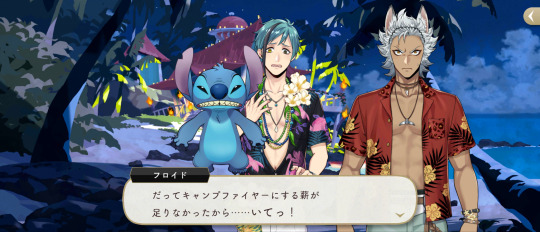
oh and floyd being floyd, the wood he used for the campfire was the DOOR, he literally just took the door and burned it😭 (stitch smacks him for it)
also they put lilia in charge of gathering food, and he gave azul some "nutritious" fruit
azul passed out immediately and he said his mouth was numb rip your husband aubbie @azulashengrottospiano
lilia starts making everyone dance to the music, the first years all of fun, meanwhile azul and riddle compete over who can dance better (they're both complete amateurs, but riddle's movements are extremely stiff and azul makes fun of him and says he can dance better)
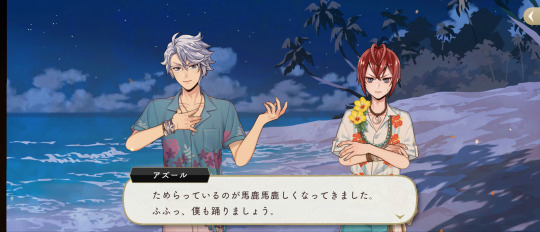
tagging you guys cuz i think you'll be interested hehe @dove-da-birb @identity-theft-101 @officialdaydreamer00 @hheun @fukashiin @silvers-numberonefan @siren-serenity
#im so in love with this event#and also floyd???#the fact that hes so cute with stitch#and stitch smacked him and he didn't even get angry#just an “ouch! what was that for”#chefs kiss#also this is all coming from my beginner level japanese so it may not be fully accurate#but im trying#so enjoy hehe#ALSO FLOYD AND STITCH GET YOUR ASSES HOME OKAY#rinna rants#twisted wonderland#twisted wonderland jp
121 notes
·
View notes
Text
Shinto Beginner Guide Version 5.8.2023
Hi everyone,
My apologies for the constant re-posting of this guide. There is always some errors I miss when I release a new version and I'm very thankful to those who help me edit and refine the guide over time.
This is the most recent version as of May 8th 2023. Instead of a zip file, I've compiled it all in a single PDF you can download Here
In addition, this time I've also made a convenient online version from this link: www.livingwithkami.com/beginner
For a practical reference, there is a list of shrines overseas, where to receive sacred items, a reading list, and a list of Norito as well.
I hope this can help our community and be an accessible resource.
I give my deep thanks to Kami-sama and everyone who helped me write and edit this guide, who contributed towards it, and who guided me through the years.
This guide was not written by myself alone but with the help of Kami-sama and the community.
I am only posting it here to begin with but please feel free to share it anywhere you like.
I may have to update it again this Autumn depending on the changes in the community, but this is the most recent version.
Thank you very much.
Sincerely,
Rev. Olivia
#shinto#shintoism#shinto religion#shinto guide#shinto beginner#shinto beginner guide#shinto starter guide#shinto starter#shinto newcomer#japanese religion#resource#shinto resource#japan#japanese culture
116 notes
·
View notes